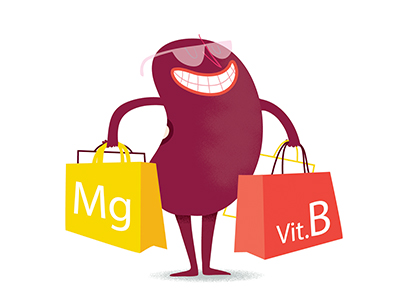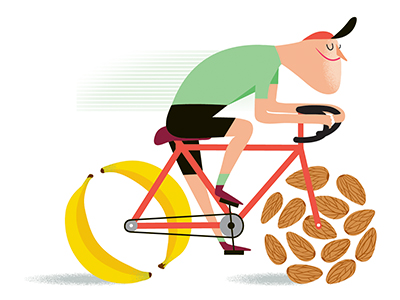Not all carbs are created equal
It’s true: Some carbohydrate-containing foods aren’t exactly nutritious. Foods that are high in added sugar, or are made from refined flour (like soda, white bread, sweets and sugary cereals), cause a rapid spike in blood sugar, also known as glucose, followed by a crash that can leave you feeling shaky, irritable and craving more sugar. On the other hand, the carbohydrates found in whole grains, legumes, fruits and vegetables tend to be released into your bloodstream more slowly, keeping your blood sugar—and energy—steady.
Tip: For best blood-sugar control, pair carbs with a bit of protein like fish, eggs, almonds, peanut butter or yogurt. The protein slows digestion, which means the carb-containing foods break down gradually. The result is you’ll not only have more energy, you’ll feel more full (and less likely to raid the kids’ candy stash an hour later).

Work it out
Carbs are your body’s primary fuel source during vigorous exercise, like running, team sports, cycling or that early-morning boot camp you love to hate. Having a carb-based meal or snack an hour or two before you exercise can make your workout feel easier, and can even allow you to exercise at a higher intensity.
Tip: While we love fibre for all its health benefits (see "Fibre is your friend"), the moment to limit your fibre intake is right before your workout. The reason is simple: Fibre is slow to digest, and can make you gassy. And while a bit of gas is actually a good sign that the bacteria inside your digestive system are happily enjoying their meal, it’s not exactly great news for your carpool companions or yoga neighbour. Instead of munching on bran cereal or a bean salad, try a banana and some yogurt, or whole-grain toast with a bit of almond butter, in the hour or two before your workout—you’ll be well fuelled, and you’ll keep your belly happy to boot.
How much is a serving?
When it comes to grains, serving size matters. While many of us assume that a serving is whatever we are inclined to eat, in reality, a serving of grains, according to Canada’s Food Guide, can be one of the following:
- ½ cup cooked pasta, rice, quinoa or couscous
- 1 slice of bread
- ½ of a large pita or tortilla (or 1 small)
- ¾ cup cooked oats or hot cereal
- 1 oz (30 g) cold cereal (½ to ¼ cups, depending on the brand)
While those servings might seem a bit scant, don’t worry: According to the Food Guide, an adult male needs eight servings of grains per day, while women should aim for six to seven servings per day. This means most people can afford to enjoy two servings per meal. While the Food Guide recommends that you try to choose whole-grain foods at least half the time, it’s a win-win if you try to make all of your grains whole, whenever possible. And remember: You don’t need permission to grab a slice of pizza, order a big, comforting bowl of spaghetti or whip up a delicious, crusty French baguette sandwich from time to time. Life is about balance.
Brain food
The brain is basically a glucose hog. If you’re awake and even moderately alert, odds are your brain is churning through glucose: 20% to 30% of the energy we burn at rest goes toward brain function, and glucose is its fuel of choice. But what does this all mean? Your brain performs better when blood sugar is even, not on a roller coaster.
Tip: Instead of blood-sugar-spiking bagels and soda (followed by the inevitable sugar crash), keep your brain happily at work with a balanced lunch (cue the whole-grain wrap with turkey, hummus and plenty of greens). Add an apple and some almonds for your afternoon snack, and pass on the muffin or chocolate bar to avoid the energy-zapping mid-afternoon dip. Your brain—and your boss—will thank you.
Fibre is your friend
Fruits, vegetables, legumes and whole grains—all of which are important sources of carbohydrates—are also highly nutritious. In addition to fibre, they provide other essential nutrients, including:
- Magnesium An often underappreciated nutrient that helps control blood pressure and maintain happy and healthy digestion, magnesium naturally occurs in whole grains, like quinoa and whole wheat, and legumes, in particular black and red kidney beans.
- Soluble fibre A type of dietary fibre, soluble fibre is important for cholesterol control. Bonus: It also helps to keep you regular. You’ll find soluble fibre in oats and oat bran, barley, apples, pears, lentils and legumes.
- B vitamins and folate B vitamins help our body convert food to energy, keep our nervous system functioning properly and build red blood cells. Folate (also known as vitamin B9) is particularly important for heart and brain health, and can help prevent birth defects. Chickpeas, lentils and beans are big sources of folate: A one-cup serving can provide over half of your day’s needs.
Packing nutrient punch
Fibre is a type of carbohydrate. And without carbs, it’s awfully difficult to get enough all-important dietary fibre. A diet high in fibre has been associated with numerous benefits, ranging from healthy digestion to blood pressure control to reduced risk of type 2 diabetes. Fibre also feeds the good bacteria in our gut, allowing their populations to thrive. Unfortunately, most people still don’t get enough: The average adult Canadian woman consumes only about 60% of her daily fibre needs, while men only eat about half of their recommended intake.
These carb-based foods are some of the most fibre-rich around:
- Legumes (also known as pulses) such as chickpeas, lentils and beans
- Berries like blueberries, blackberries, strawberries, raspberries and cranberries
- Fruit especially pears and apples
- Vegetables especially asparagus, broccoli, potatoes (with the skin on) and parsnips
- Whole grains like whole wheat, oats, quinoa, barley and wild rice
Go with the grain
All grains start off as whole grains, a.k.a. the entire seed of a plant, and are made up of three key edible parts:
- The bran is the multi-layered outer skin of the edible kernel and is full of B vitamins, fibre and important antioxidants.
- The germ is where new plants can sprout—it’s the grain’s embryo. This is where you’ll find B vitamins, protein, minerals and healthy fats.
- The endosperm, which serves as the germ’s food supply, is the largest part of the kernel and contains starchy carbohydrates, proteins and trace amounts of vitamins and minerals.
The whole grain picture

According to a number of studies, people who consume whole grains tend to have a lower risk of chronic diseases (like type 2 diabetes and heart disease). Whole grains include all three parts of the grain: the bran, the germ and the endosperm (see sidebar). Refined grains, like the ones found in white bread, white pasta, burger and hot dog buns, pizza dough and many desserts or baked goods, have had the bran and germ removed. This means that not only are a lot of the fibre, B vitamins and magnesium missing, but the carbs break down more quickly, causing a spike and crash in our blood sugar.
Tip: While whole wheat is nutritious, try to experiment with other, less common (but still delicious!) grains, like barley, buckwheat, quinoa, amaranth, millet, spelt, wild rice and oats. Many can be used in lieu of rice in recipes, such as a pilaf, or can be made into porridges or added to soups and cold salads.
And last but not least: carbs don't cause weight gain
Carbs make you fat, right? Not so fast. While a lot of popular diets suggest carbs are an automatic trigger for a bigger belly, the truth is that what makes us gain weight is overeating—which could happen with any combination of protein, fat or carbohydrates. You should always pay attention to your portions, since restaurants commonly serve far more pasta, rice (or French fries!) than most people need. As long as you keep your portions sensible, carbs should be part of a healthy, balanced diet.
Tip: A portion of cooked rice is just half a cup cooked, while a typical meal can contain many times this amount. Replace half the rice with vegetables, and cook with brown rice when possible.
